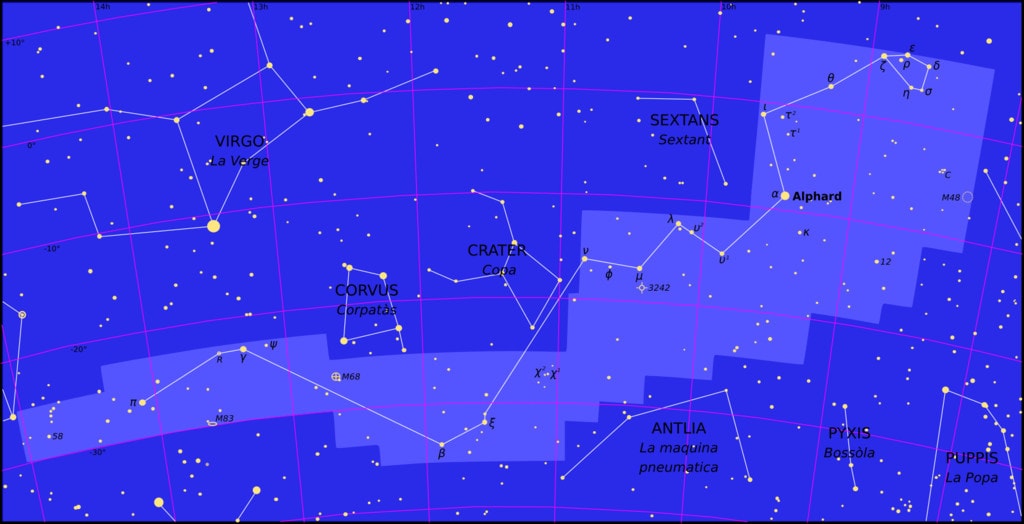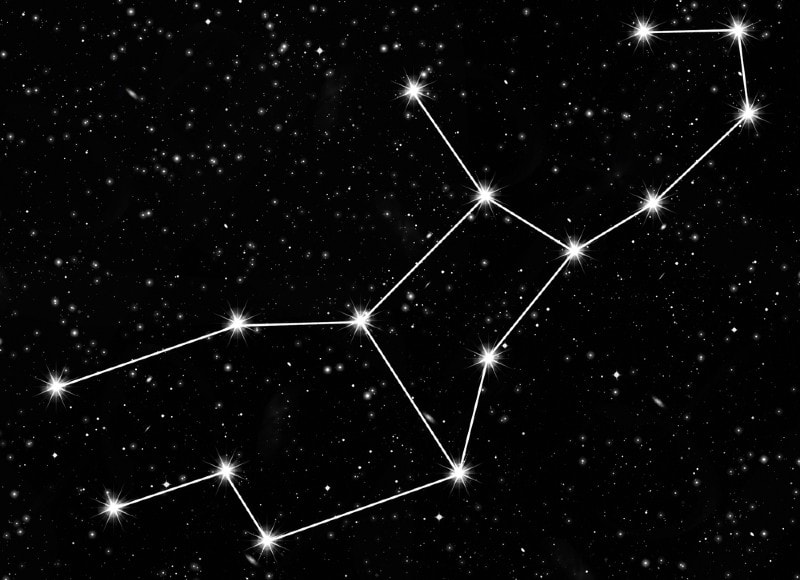What Is the Largest Constellation in the Sky? The Interesting Answer!
Last Updated on

There are 88 constellations in the sky, and some can even be seen with the naked eye. Recognizing the constellations is a skill everyone can learn, and the gift of spotting them is truly special.
If you are dipping your toes into the world of stargazing, spotting the largest constellation would be a good start. The largest and longest constellation is Hydra. Also known as the water snake, it occupies 3.158% of the sky, and the entire constellation can be seen from several parts of the world.

How Big Is Hydra?
Hydra is located in the southern celestial hemisphere and spans 1303 square degrees of the southern sky. It is also one of the longest constellations, stretching for more than 100 degrees. The northern end of the constellation borders Cancer, while its southern end borders Centaurus.
How Can You Find Hydra?

Hydra can be seen in the northern hemisphere from January to May; in the southern hemisphere, it is best seen in autumn. It can be spotted at latitudes ranging from 54 to -83 degrees.
The head of the water snake is a small cluster of five stars halfway between the bright stars Regulus and Procyon. If the sky is clear and dark, you can follow the snake’s body which will zig-zag marked with faint stars leading south and east for more than 90 degrees across the sky.
To further help you, the constellations surrounding Hydra are Antlia, Cancer, Canis Minor, Centaurus, Corvus, Crater, Leo, Libra, Lupus, Monoceros, Puppis, Pyxis, Sextans, and Virgo.
Which Stars Are in Hydra?
The Hydra constellation contains 13 stars with known planets and seven named stars. Approved by the IAU, their names are Alphard, Minchir, Lerna, Ukdah, Zhang, Felis, and Ashlesha.
Alphard is the brightest star, with a magnitude of 1.98. Alphard has three times the Sun’s mass and a radius 50 times that of the Sun. The second brightest star is the Gamma Hydrae, with a magnitude of 2.993. It has three times the mass of the Sun and a radius of 13 times that of the Sun. It is also 115 times larger than the Sun, despite being much younger.
Deep Sky Objects in Hydra

Hydra contains an open star cluster known as Messier 48. It is said to have a magnitude of 5.5, is 300 million years old, and is 1,500 light years from Earth. In good viewing conditions, it can be seen without binoculars.
A globular cluster known as Messier 68 has an approximate magnitude of 9.67 and is about 33,600 light years away from the solar system.
Messier 68, also known as the southern pinwheel, is a barred spiral galaxy. It is approximately 14.7 million light years away from the Sun and has a visual magnitude of 7.54.
A galaxy cluster in Hydra, known as the Hydra cluster, is 190.1 million lightyears from the solar system and spans over 10 million light years. It contains 157 bright galaxies, which are about 150,000 light years in diameter.
The ghost of Jupiter is a planetary nebula in Hydra. It is sometimes called the eye nebula and can be viewed easily through an amateur telescope.
Hydra Mythology
Hydra was said to have nine heads, with one of them being immortal. The celestial picture of Hydra is seen with only one head, which is assumed to be the immortal one. The creature was fathered by Typhon and Echidna, who were half snake and half woman.
It lived near Lerna and ravaged the countryside. Hercules attempted to smoke it out by shooting flaming arrows into its lair, then fought it by clubbing each of its heads. Legend has it that if one of the Hydra’s heads were severed, two more would grow back in its place.
Hercules defeated the serpent by cutting off its immortal head and burying it under a rock. He then dipped his arrows in Hydra’s blood, leading to his demise.
Another mythical story associated with Hydra is with a water snake served to Apollo by his crow when he was sent to fetch him water. The crow got distracted and stopped to eat figs off a tree. The crow blamed the snake, but Apollo sniffed out his lies, and as punishment, he placed him in the sky.
Apollo also turned the cup and the snake into constellations. The crow is represented by the constellation Corvus, and the cup is represented by the constellation Crater.
What is the Second Largest Constellation?

Virgo is the second largest constellation in the sky, spanning an area of 1,294 degrees. Virgo has no distinct pattern of stars, unlike other constellations, but is known as the fair maiden and one of the zodiac constellations. It can be found between Leo to the west and Libra to the east, and its brightest star, Spica, can help you find it.
Hydra Quick Facts
- The Term Hydra means “water snake”
- The closest main star in the constellation is 100.98 light years away, and the farthest main star is 62 light years away
- Alphard is the brightest star in the constellation
- Hydra belongs to the Hercules family, the largest family that consists of 19 constellations
- The first astronomer to catalog this constellation was Greek astronomer Ptolemy
- It is most visible in April at 9 pm
- Hydra contains three Messier objects and has 13 with known planets

Final Thoughts
Hydra is known to be the largest constellation in the sky. It spans over 3.158 % of the sky and can be seen almost anywhere in the world. It comprises many known stars, the brightest being Alphard, including 19 constellations, star clusters, and galaxies. Hydra is best seen in the northern hemisphere from January to May, and in the southern hemisphere, it is best seen in autumn.
Featured Image Credit: Constellacion Hydra (Nicolas Eynaud, via Wikimedia Commons CC BY-SA 4.0)
About the Author Robert Sparks
Robert’s obsession with all things optical started early in life, when his optician father would bring home prototypes for Robert to play with. Nowadays, Robert is dedicated to helping others find the right optics for their needs. His hobbies include astronomy, astrophysics, and model building. Originally from Newark, NJ, he resides in Santa Fe, New Mexico, where the nighttime skies are filled with glittering stars.
Related Articles:
What Is the Best Binocular Magnification for Hunting? Optical Features Explained
15 Crucial Facts About Ultraviolet Rays & the Sun
What Constellation Is Spica In? The Interesting Answer!
10 Interesting Leo Constellation Facts, Myths, and FAQs
15 Interesting Pegasus Constellation Facts, Myths, and FAQs
6 Interesting Sagittarius Constellation Facts, Myths, and FAQs in 2024!
What Are Constellations? Where Did They Come From?
8 Interesting Libra Constellation Facts, Myths, and FAQs
